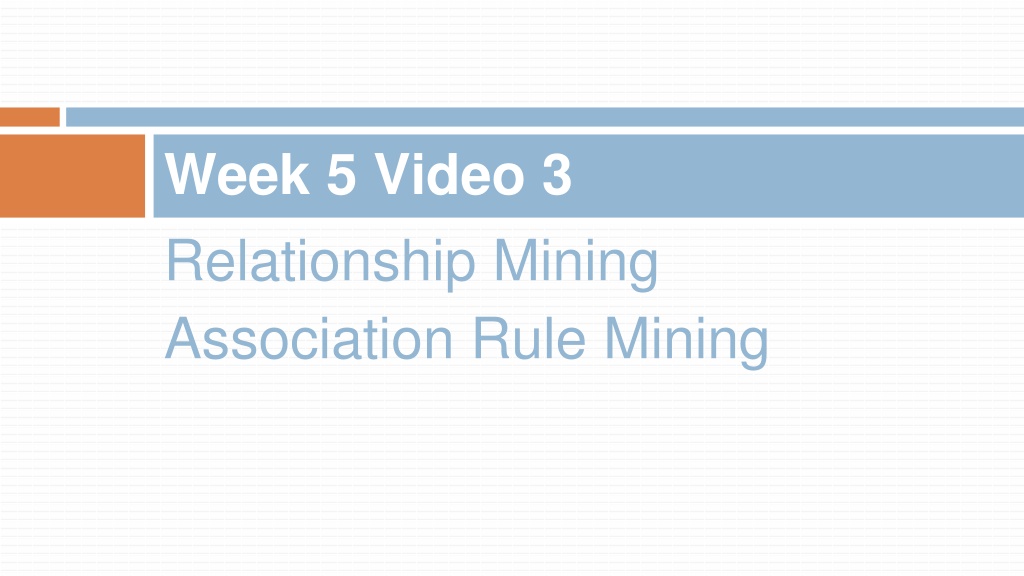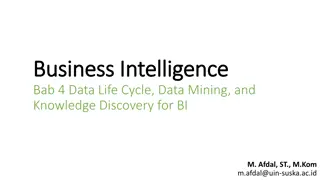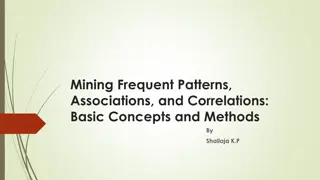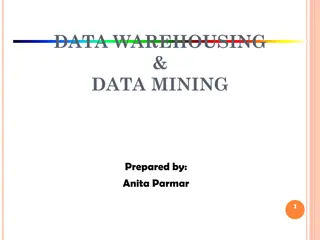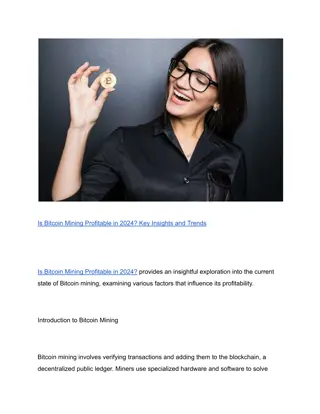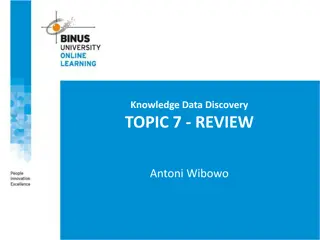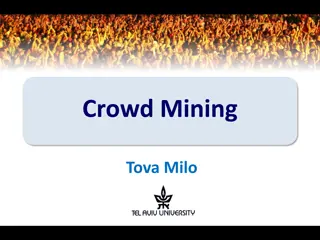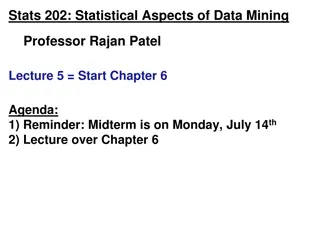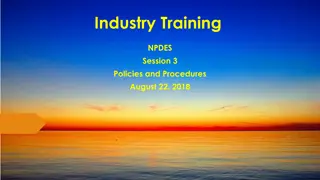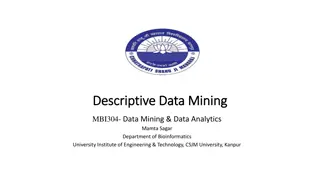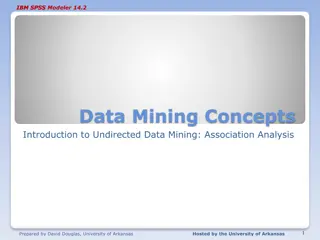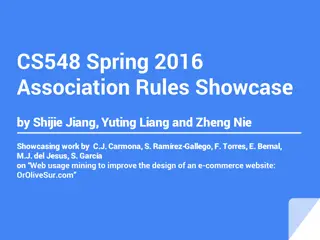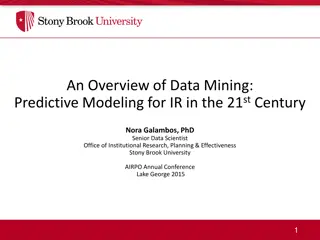Exploring Association Rule Mining in Data Analysis
Association rule mining involves automatically discovering simple if-then rules within a dataset. This process can unveil interesting relationships and patterns, leading to generating hypotheses for further study and finding unexpected connections. While association rules imply causality by their if-then nature, it is crucial to understand that causality can go in either direction. The rules can range from straightforward to complex conditions, impacting decision-making processes in various fields.
Download Presentation

Please find below an Image/Link to download the presentation.
The content on the website is provided AS IS for your information and personal use only. It may not be sold, licensed, or shared on other websites without obtaining consent from the author. Download presentation by click this link. If you encounter any issues during the download, it is possible that the publisher has removed the file from their server.
E N D
Presentation Transcript
Week 5 Video 3 Relationship Mining Association Rule Mining
Association Rule Mining Try to automatically find simple if-then rules within the data set
Example Famous (and fake) example: People who buy more diapers buy more beer If person X buys diapers, Person X buys beer Conclusion: put expensive beer next to the diapers
Interpretation #1 Guys are sent to the grocery store to buy diapers, they want to have a drink down at the pub, but they buy beer to get drunk at home instead
Interpretation #2 There s just no time to go to the bathroom during a major drinking bout
Serious Issue Association rules imply causality by their if- then nature But causality can go either direction
If-conditions can be more complex If person X buys diapers, and person X is male, and it is after 7pm, then person Y buys beer
Then-conditions can also be more complex If person X buys diapers, and person X is male, and it is after 7pm, then person Y buys beer and tortilla chips and salsa Can be harder to use, sometimes eliminated from consideration
Useful for Generating hypotheses to study further Finding unexpected connections Is there a surprisingly ineffective instructor or math problem? Are there e-learning resources that tend to be selected together?
Association Rule Mining Find rules Evaluate rules
Association Rule Mining Find rules Evaluate rules
Rule Evaluation What would make a rule good ?
Rule Evaluation Support/Coverage Confidence Interestingness
Support/Coverage Number of data points that fit the rule, divided by the total number of data points (Variant: just the number of data points that fit the rule)
Example Rule: If a student took Advanced Data Mining, the student took Intro Statistics Took Adv. DM 1 0 0 0 0 0 1 1 1 1 1 Took Intro Stat. 1 1 1 1 1 1 0 0 0 0 1 Support/coverage?
Example Rule: If a student took Advanced Data Mining, the student took Intro Statistics Took Adv. DM 1 0 0 0 0 0 1 1 1 1 1 Took Intro Stat. 1 1 1 1 1 1 0 0 0 0 1 Support/coverage? 2/11= 0.1818
Confidence Number of data points that fit the rule, divided by the number of data points that fit the rule s IF condition Equivalent to precision in classification Also referred to as accuracy, just to make things confusing NOT equivalent to accuracy in classification
Example Rule: If a student took Advanced Data Mining, the student took Intro Statistics Took Adv. DM 1 0 0 0 0 0 1 1 1 1 1 Took Intro Stat. 1 1 1 1 1 1 0 0 0 0 1 Confidence?
Example Rule: If a student took Advanced Data Mining, the student took Intro Statistics Took Adv. DM 1 0 0 0 0 0 1 1 1 1 1 Took Intro Stat. 1 1 1 1 1 1 0 0 0 0 1 Confidence? 2/6 = 0.33
Important Note Implementations of Association Rule Mining sometimes differ based on whether the values for support and confidence (and other metrics) Are calculated based on exact cases Or some other grouping variable (sometimes called customer in specific packages)
For example Frustrated Time N 0 0 0 0 0 0 1 1 1 1 1 Bored Time N+1 0 0 0 0 0 1 1 1 1 0 1 Let s say you are looking at whether boredom follows frustration If Frustrated at time N, Then Bored at time N+1
For example If you just calculate it this way, Frustrated Time N 0 0 0 0 0 0 1 1 1 1 1 Bored Time N+1 0 0 0 0 0 1 1 1 1 0 1 Confidence = 4/5
For example But if you treat student as your customer grouping variable Student Frustrated Time N 0 0 0 0 0 0 1 1 1 1 1 Bored Time N+1 0 0 0 0 0 1 1 1 1 0 1 A B C A B C A C C A C Then whole rule applies for A, C And IF applies for A, C So confidence = 1
Arbitrary Cut-offs The association rule mining community differs from most other methodological communities by acknowledging that cut-offs for support and confidence are arbitrary Researchers typically adjust them to find a desirable number of rules to investigate, ordering from best-to-worst Rather than arbitrarily saying that all rules over a certain cut-off are good
Other Metrics Support and confidence aren t enough Why not?
Why not? Possible to generate large numbers of trivial associations Students who took a course took its prerequisites (AUTHORS REDACTED, 2009) Students who do poorly on the exams fail the course (AUTHOR REDACTED, 2009)
Interestingness Not quite what it sounds like Typically defined as measures other than support and confidence Rather than an actual measure of the novelty or usefulness of the discovery
Potential Interestingness Measures Cosine P(A^B) sqrt(P(A)*P(B)) Measures co-occurrence Merceron & Yacef (2008) note that it is easy to interpret (numbers closer to 1 than 0 are better; over 0.65 is desirable)
Example Rule: If a student took BDEMOOC, the student published EDM paper Took BDEMOOC 1 0 0 0 0 0 1 1 1 1 Published EDM Paper 1 1 0 0 0 0 1 1 0 1 Cosine? P(A^B) sqrt(P(A)*P(B)) (0.4)/sqrt(0.5*0.5) = 0.8
Potential Interestingness Measures Lift Confidence(A->B) P(B) P(A^B) P(A)*P(B) = Measures whether data points that have both A and B are more common than would be expected from the base rate of each Merceron & Yacef (2008) note that it is easy to interpret (lift over 1 indicates stronger association)
Example Rule: If a student took BDEMOOC, the student published EDM paper Took BDEMOOC 1 0 0 0 0 0 1 1 1 1 Published EDM Paper 1 1 0 0 0 0 1 1 0 1 Lift? P(A^B) P(A)*P(B) (0.4)/(0.5*0.5) = 1.6
Merceron & Yacef recommendation Rules with high cosine or high lift should be considered interesting
Other Interestingness measures (Tan, Kumar, & Srivastava, 2002)
Worth drawing your attention to Jaccard P(A^B) P(A)+P(B)- P(A^B) Measures the relative degree to which having A and B together is more likely than having either A or B but not both
Other idea for selection Select rules based both on interestingness and based on being different from other rules already selected (e.g., involve different operators)
Alternate approach (Bazaldua et al., 2014) Compared interestingness measures to human judgments about how interesting the rules were They found that Jaccard and Cosine were the best single predictors And that Lift had predictive power independent of them But they also found that the correlations between [Jaccard and Cosine] and [human ratings of interestingness] were negative For Cosine, opposite of prediction in Merceron & Yacef!
Association Rule Mining Find rules Evaluate rules
The Apriori algorithm (Agrawal et al., 1996) 1. Generate frequent itemset 2. Generate rules from frequent itemset
Generate Frequent Itemset Generate all single items, take those with support over threshold {i1} Generate all pairs of items from items in {i1}, take those with support over threshold {i2} Generate all triplets of items from items in {i2}, take those with support over threshold {i3} And so on Then form joint itemset of all itemsets
Generate Rules From Frequent Itemset Given a frequent itemset, take all items with at least two components Generate rules from these items E.g. {A,B,C,D} leads to {A,B,C}->D, {A,B,D}->C, {A,B}->{C,D}, etc. etc. Eliminate rules with confidence below threshold
Finally Rank the resulting rules using your interest measures
Other Algorithms Typically differ primarily in terms of style of search for rules
Variant on association rules Negative association rules (Brin et al., 1997) What doesn t go together? (especially if probability suggests that two things should go together) People who buy diapers don t buy car wax, even though 30-year old males buy both? People who take advanced data mining don t take hierarchical linear models, even though everyone who takes either has advanced math? Students who game the system don t go off-task?
Next lecture Sequential Pattern Mining
